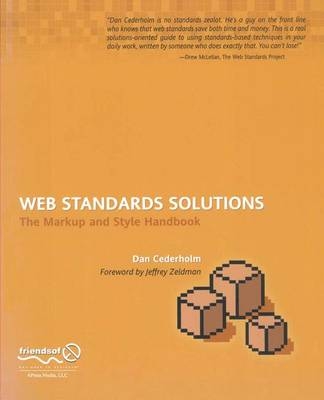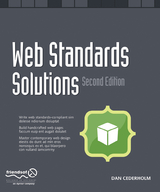
Web Standards Solutions
The Markup and Style Handbook
Seiten
2004
Apress (Verlag)
978-1-59059-381-3 (ISBN)
Apress (Verlag)
978-1-59059-381-3 (ISBN)
- Titel erscheint in neuer Auflage
- Artikel merken
Zu diesem Artikel existiert eine Nachauflage
This title contains questions and answers on mark-up and style topics for Web Standards. It explores the multiple ways you can handle a situation when building with Web Standards and the advantages and disadvantages of those methods. Each chapter goes a step further, with "extra credit" sections to give the reader extra tips and tricks.
Web standards are the standard technology specifications enforced by the World Wide Web Consortium (W3C) to make sure that web designers and browser manufacturers are using the same technology syntax. It is important that these implementations are the same throughout the Web, otherwise it becomes a messy proprietary place, and lacks consistency. These standards also allow content to be more compatible with multiple different viewing devices, such as screen readers for people with vision impairments, cell phones, PDFs, etc. HTML, XML, and CSS are all such technologies. This book is your essential guide to understanding the advantages you can bring to your web pages by implementing web standards and precisely how to apply them. Web standards such as XHTML and CSS are now fairly well-known technologies, and they will likely be familiar to you, the web designer-indeed, they are all around you on the Web. However, within web standards still lies a challenge-while the browser's support for web standards is steadily increasing, many web developers and designers have yet to discover the real benefits of web standards and respect the need to adhere to them.The real art is in truly understanding the benefits and implementing the standards efficiently.
As a simple example of its power, you can use CSS to lay out your pages instead of nesting tables-this can make file sizes smaller, allowing pages to load faster, ultimately increasing accessibility for all browsers, devices, and web users. Use XHTML elements correctly so that your markup is compact and more easily understood. Use CSS to style different elements of a web page. Lay out pages easily and effectively. Compare multiple methods of achieving the same results to make better design choices. Learn about advanced web design techniques and their important caveats. Web Standards Solutions is broken down into 16 short chapters, each covering the theory and practice of different web standards concept and showing multiple solutions to given problems for easy learning. You'll learn about multi-column layouts, using image replacement techniques to your best advantage, making the best use of tables and lists, and many more.This highly modular approach allows you to rapidly digest, understand, and utilize the essentials of web standards.
Web standards are the standard technology specifications enforced by the World Wide Web Consortium (W3C) to make sure that web designers and browser manufacturers are using the same technology syntax. It is important that these implementations are the same throughout the Web, otherwise it becomes a messy proprietary place, and lacks consistency. These standards also allow content to be more compatible with multiple different viewing devices, such as screen readers for people with vision impairments, cell phones, PDFs, etc. HTML, XML, and CSS are all such technologies. This book is your essential guide to understanding the advantages you can bring to your web pages by implementing web standards and precisely how to apply them. Web standards such as XHTML and CSS are now fairly well-known technologies, and they will likely be familiar to you, the web designer-indeed, they are all around you on the Web. However, within web standards still lies a challenge-while the browser's support for web standards is steadily increasing, many web developers and designers have yet to discover the real benefits of web standards and respect the need to adhere to them.The real art is in truly understanding the benefits and implementing the standards efficiently.
As a simple example of its power, you can use CSS to lay out your pages instead of nesting tables-this can make file sizes smaller, allowing pages to load faster, ultimately increasing accessibility for all browsers, devices, and web users. Use XHTML elements correctly so that your markup is compact and more easily understood. Use CSS to style different elements of a web page. Lay out pages easily and effectively. Compare multiple methods of achieving the same results to make better design choices. Learn about advanced web design techniques and their important caveats. Web Standards Solutions is broken down into 16 short chapters, each covering the theory and practice of different web standards concept and showing multiple solutions to given problems for easy learning. You'll learn about multi-column layouts, using image replacement techniques to your best advantage, making the best use of tables and lists, and many more.This highly modular approach allows you to rapidly digest, understand, and utilize the essentials of web standards.
From the contents: Lists.- Headings.- Tables are Evil?- Quotes.- Essential Elements.- Blockquotes.- and .- Forms.- More Lists.- Anchors.- Applying CSS to a Document.- How Can I Make Hypertext Look Cool?- Multi-column Layouts.- How do I Float an Image?- Image Replacement Techniques.- Creating Different Layouts from the Same Markup Structure.
| Erscheint lt. Verlag | 11.6.2004 |
|---|---|
| Verlagsort | New York |
| Sprache | englisch |
| Maße | 180 x 230 mm |
| Gewicht | 567 g |
| Einbandart | Paperback |
| Themenwelt | Informatik ► Web / Internet ► Web Design / Usability |
| ISBN-10 | 1-59059-381-2 / 1590593812 |
| ISBN-13 | 978-1-59059-381-3 / 9781590593813 |
| Zustand | Neuware |
| Haben Sie eine Frage zum Produkt? |
Mehr entdecken
aus dem Bereich
aus dem Bereich
alles, was Sie über Gestaltung im Web wissen sollten
Buch | Softcover (2023)
Rheinwerk (Verlag)
CHF 41,85
das umfassende Handbuch
Buch | Hardcover (2023)
Rheinwerk (Verlag)
CHF 69,85



